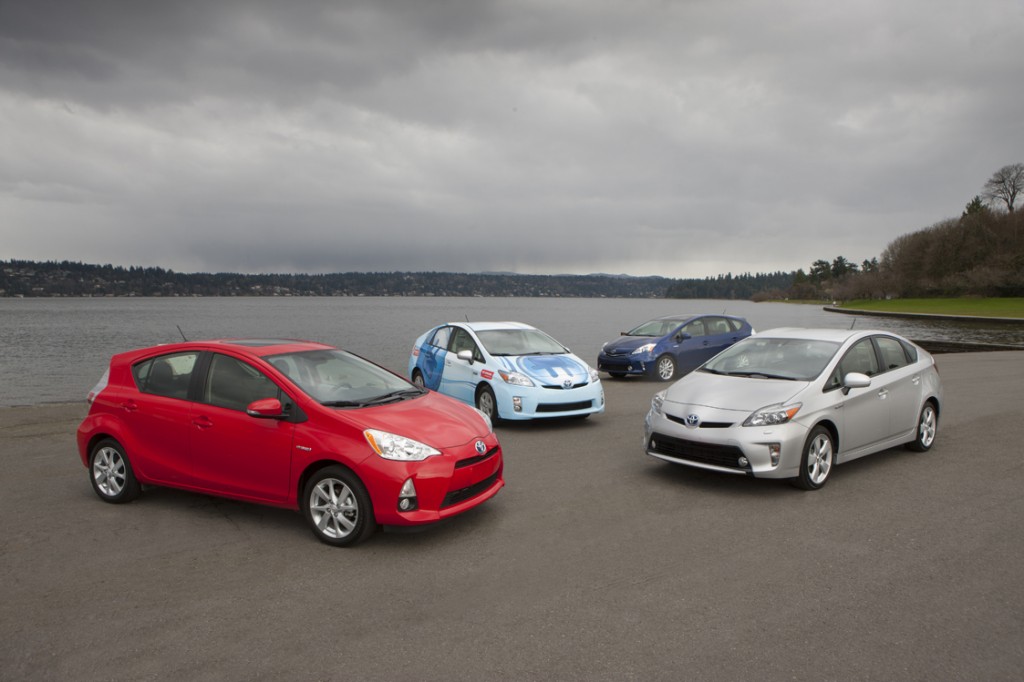Toyota says next Prius will be “significantly” more fuel efficient, weigh less, drive better
Story by John LeBlanc
YPSILANTI, MICH. — For Toyota, any discussion about the future of its hybrid vehicle strategy begins and ends with its iconic Prius. An all-new model is due in the next two years, and during the Japanese automaker’s Hybrid World Tour media event, plenty of hints and clues were dropped as to what we can expect the next-generation of Toyota hybrids will perform like and cost.
The next Prius will be “significantly” more fuel efficient, weigh less, drive better, and cost less to purchase, according to Satoshi Ogiso, managing officer at Toyota.
“The performance of this next generation of powertrains will reflect significant advances in battery, electric motor and gas engine technologies,” Ogiso said at the media event held just outside of Detroit.

I liken Ogiso as the Steve Jobs of Toyota. As a young engineer, he was part of the small team that started up Project G21 (short for Global 21st Century) in 1993. The goal was to create a car that sipped half the fuel of a contemporary Toyota compact, cut emissions in half, and drop development time by two years. The result was the first-generation, 1997 Prius, of which Ogiso was the assistant chief engineer.
We all know has happened since then. What was thought of as a science experiment has gone on to become one of the most significant automobiles of the past century. The popularity of Toyota’s Prius changed not only how the automaker developed vehicles internally, but also forced rivals to copy. Even with most major automakers jumping on the hybrid bandwagon, Toyota’s technology still dominates the sales charts. More than five million Toyota hybrid vehicles have been sold around the world since the first Prius in Japan. In Canada last year, more than 80% of hybrids sold wore a Toyota or Lexus badge.
Along with the Prius, there are 23 different Toyota or Lexus hybrid models sold globally, all of which were assembled for the media to briefly test drive here in Ypsilanti, Mich., ranging from the European-market Toyota Yaris Hybrid subcompact to the Japanese-market Toyota Alphard HV hybrid minivan. But the car the media wanted to talk about the most was the one vehicle not present: the next-generation Prius.

While Toyota won’t confirm a launch date, based on previous Prius life cycles, we can expect the next Prius to arrive sometime in 2015.
Although details were not forthcoming, Ogiso said that the next-generation Prius’s electric motors would be smaller in size yet deliver more power. The hybrid’s gas engine’s thermal efficiency will be rated at 40%, allegedly making it the “worlds best.” And the next Prius’s batteries will also have a higher energy density. The result? Toyota is shooting for a 10% reduction of the current Prius’s 50 miles per gallon rating (4.7 L/100 km) upwards to 55 mpg (4.28 L/100 km), a leap Ogiso equated to Jamaican sprinter Usain Bolt shaving a full second off his world-record 100-metre run.
Although once a quirky cult car, the sales success of the Prius — and its offspring — has led to mainstream customers buying into the Toyota hybrid mantra. As such, Toyota is also saying the next-gen Prius will be a better all-around vehicle to drive. As the first Toyota to be spawn from the automaker’s new Global Architecture platform, the next Prius will have a lower centre of gravity and increased structural rigidity, all to benefit its ride and handling characteristics. Although future pricing was not discussed, Ogiso said a less expensive hybrid system might lower the current Prius’s $26,100 price.

Of the various Toyota hybrids on hand for brief test drives, the vehicle that gives the best clues as to how the next Prius may drive is the current Toyota Auris Hybrid. Just introduced to the European market last fall as a hatchback and wagon, the Auris was designed to get European drivers out of their diesel-engine compacts. As such, the Auris sports a multi-link rear suspension instead of the current Prius’s torsion beam setup. It’s no sports car to drive, but the Auris’s ride is more supple and compliant than the current Prius. And from a packaging standpoint, the Auris’s battery pack is mounted under the rear seat instead of the trunk floor, which allows it to have the same cargo space as its gas and diesel engine counterparts.
Some people have asked if gas-electric hybrids are merely a “bridge” technology until something better comes along, like pure-electric or hydrogen fuel cell vehicles. (Despite its hybrid success, Toyota continues to work on these other alternative technologies to gas-only cars. In fact, the automaker’s first commercial hydrogen fuel cell vehicle will debut next January and become available in 2015.) But Toyota feels its hybrid experience gives it a head start with other green cars, like plug-in hybrids, pure-electric vehicles and hydrogen vehicles.
As Bob Carter, Toyota’s senior vice-president of automotive operations in the U.S., projected, “The next 15 years belong to hybrids.”






![[del.icio.us]](https://www.straight-six.com/wp-content/plugins/bookmarkify/delicious.png)
![[Digg]](https://www.straight-six.com/wp-content/plugins/bookmarkify/digg.png)
![[Facebook]](https://www.straight-six.com/wp-content/plugins/bookmarkify/facebook.png)
![[Google]](https://www.straight-six.com/wp-content/plugins/bookmarkify/google.png)
![[Reddit]](https://www.straight-six.com/wp-content/plugins/bookmarkify/reddit.png)
![[StumbleUpon]](https://www.straight-six.com/wp-content/plugins/bookmarkify/stumbleupon.png)
![[Twitter]](https://www.straight-six.com/wp-content/plugins/bookmarkify/twitter.png)
![[Email]](https://www.straight-six.com/wp-content/plugins/bookmarkify/email.png)